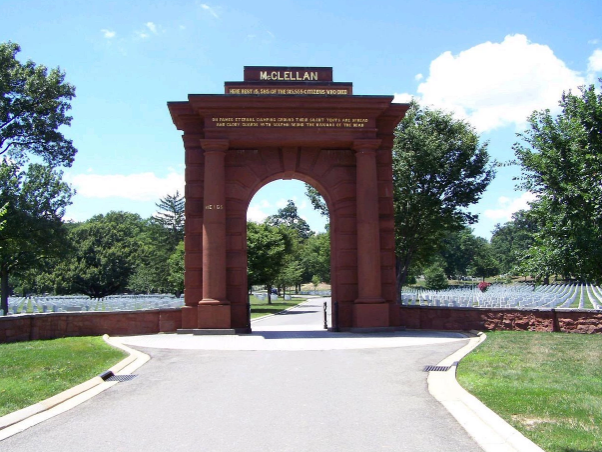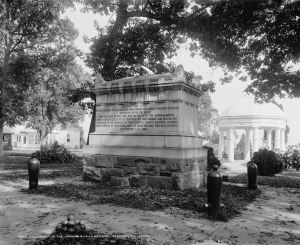Montgomery Meigs: Visionary of Arlington Cemetery

The founding of Arlington National Cemetery followed a tumultuous four years as the country was embroiled in civil war. While many people and events helped to establish Arlington, none were more influential in the effort than Brigadier General Montgomery Meigs. During the Civil War, Meigs served as the Quartermaster General for the Union Army. He saw to the outfitting of Union troops with food, supplies and ammunition, organized campaigns, and helped track the course of the war. As caravans of Union casualties continued to fill the streets and cemeteries of Washington, the government was in desperate need of land in which to inter these fallen soldiers. In 1864 the Office of the Quartermaster General was tasked with identifying the site of a new government cemetery. Meigs knew just the place—Arlington, which had been the home and estate of Confederate General Robert E. Lee.
During his early years as a soldier in the Army Corps of Engineers, Meigs had studied and worked under General Lee, whom he regarded as an impressive leader and sharp engineer. However, in May 1861, when word spread that Lee had resigned his army commission and joined Jefferson Davis in Richmond, Meigs turned from comrade to adversary. Meigs considered the entire Lee family to be traitorous criminals, and executed his vengeance by encouraging the government to seize the Lee family property at Arlington to be used as a cemetery for Union dead. The Union Army occupation began in 1861, and by 1864, the army began burying soldiers along the Northern border of the Arlington estate. The government legally acquired the property in public auction in January of 1864, and Meigs began building his vision of a national cemetery.
 The selection of Arlington is jointly credited to President Abraham Lincoln and General Meigs. The (perhaps apocryphal) moment of inspiration came when Lincoln and Meigs were visiting the military encampment at Arlington on May 13, 1864. As the Presidential carriage toured the grounds, Lincoln and Meigs observed laborers unceremoniously loading wagons with dozens of dead soldiers from Arlington Hospital, bound for burial at the Soldier’s Home in Northern Washington. Meigs supposedly stopped the caravan and ordered the soldiers to be buried immediately on the spot. The Washington cemeteries were overflowing with Union casualties, and Meigs had found his new cemetery site.
The selection of Arlington is jointly credited to President Abraham Lincoln and General Meigs. The (perhaps apocryphal) moment of inspiration came when Lincoln and Meigs were visiting the military encampment at Arlington on May 13, 1864. As the Presidential carriage toured the grounds, Lincoln and Meigs observed laborers unceremoniously loading wagons with dozens of dead soldiers from Arlington Hospital, bound for burial at the Soldier’s Home in Northern Washington. Meigs supposedly stopped the caravan and ordered the soldiers to be buried immediately on the spot. The Washington cemeteries were overflowing with Union casualties, and Meigs had found his new cemetery site.
While Meigs was known for his deep military sense of propriety and patriotic duty, he was also a shrewd and calculating bureaucrat, and held deep resentment toward Lee. In an effort to make Arlington as uninhabitable as possible, should the Lee family attempt to return, Meigs directed the first burials of prominent Union officers to be as close to Arlington Mansion, the Lee family home, as possible. By June 1864, at least seven Union officers had been laid to rest on the borders of Mrs. Lee’s flower garden.
By the end of the war in 1865, over 12,000 Union soldiers were interred at Arlington. However, Meigs was still wary of the Lee family’s claims to the land, and constantly cautioned his superiors to make sure the government’s hold on the property was legally secure. To further entrench Arlington as a national cemetery, Meigs set out to locate and rebury thousands of Union soldiers, interred in battlefields, churchyards and wilderness throughout the country. The initially modest effort to populate Arlington blossomed into a patriotic duty to find, identify, and honor Union casualties. Meigs sought to rebury as many Union soldiers as possible, along with identifying their name, rank, and unit, to help families identify their loved ones. This campaign to recover the dead became one of the largest and most carefully orchestrated national efforts to date. “Such a consecration of a nation’s power and resources to a sentiment, the world has never witnessed,” observed Quartermaster Edmund Whitman of Meigs’s project. In 1870, when the reburial efforts ended, over 315,000 soldiers had been accounted for. For those bodies that could not be identified, Meigs designed a mass grave site to honor the anonymous Union dead, serving as the first memorial to unknown soldiers in the cemetery.

After most of the re-internments had been completed, Meigs set to embellishing Arlington National Cemetery with his own aesthetic vision. Throughout his career, Meigs had demonstrated an aptitude for engineering and architecture, and had strong design sensibilities. While developing Arlington, Meigs also supervised designs for the National Museum (now known as the Arts and Industries Building), the Washington Aqueduct system, an expansion of the Capitol Building, including a new dome, and the Pension Office (now known as the National Building Museum).
At Arlington, Meigs designed and commissioned mausoleums, statuettes, Tanner amphitheater, and the McClellan Arch, which framed the cemetery’s main entrance. In a move characteristic of Meigs’ well documented ego, he inscribed his name in gold on the south column below the arch. Meigs was involved in every step at Arlington—he chose plantings, directed workers in their repairs of the Mansion, and even dictated the composition of soil used to landscape the grounds. When the question of replacing wooden tombstones arose, Meigs recommended galvanized iron as a long lasting, cost effective and durable option. A nationwide headstone replacement program was enacted in 1873, but Meigs’s particular suggestion was rejected in favor of the marble and granite we see today.
 Meigs’ final influences at Arlington involved securing his own family into the fabric of the cemetery. He claimed a beautiful hilltop plot just to the west of the Lee Mansion off Meigs Drive, in Section 1, Row 1. Meigs’ wife, Louisa, was the first to be interred there in 1879. Meigs also had his son, Lt. John Rogers Meigs, who had been killed in the Civil War, moved to their plot, along with many other relatives. Meigs’ last design for Arlington was his own massive white marble sarcophagus, elevated on a stone pedestal with the following self-composed epitaph, encapsulating the many roles he played in our National history: “Soldier, Engineer, Architect, Scientist, Patriot.”
Meigs’ final influences at Arlington involved securing his own family into the fabric of the cemetery. He claimed a beautiful hilltop plot just to the west of the Lee Mansion off Meigs Drive, in Section 1, Row 1. Meigs’ wife, Louisa, was the first to be interred there in 1879. Meigs also had his son, Lt. John Rogers Meigs, who had been killed in the Civil War, moved to their plot, along with many other relatives. Meigs’ last design for Arlington was his own massive white marble sarcophagus, elevated on a stone pedestal with the following self-composed epitaph, encapsulating the many roles he played in our National history: “Soldier, Engineer, Architect, Scientist, Patriot.”
#WashingtonDC #RobertELee #ArlingtonNationalCemetery #MontgomeryMeigs #CivilWar
